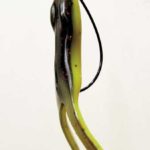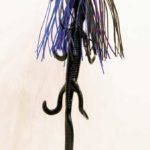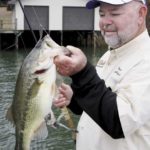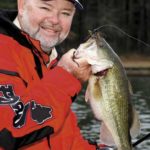
Conventional lures fished in very unconventional ways often deliver the goods.
Several years ago, during a Louisiana Bass Federation State Tournament on Lake D’Arbonne in Farmerville, I was paired up with an angler who had some crazy ideas. We were out on the channel fishing Carolina rigs, and he was absolutely smoking me.Not being too proud to change, I asked the fellow if he was doing anything different than I was. He didn’t think he was. He showed me his lure — same. He showed me his weight — same. And he showed me his leader — sa… wait a minute.
This guy was more than just a little bit confused. He had monofilament for his main line and braided line for his leader.
Now, I had just read the latest issue of BASSMASTER Magazine, and it had an article in it about the best applications for braided line. One of the suggestions was to use braided line as your main line with a Carolina rig since it had almost zero stretch, which would allow you to feel more bites, and to use mono as the leader to help absorb some of the shock of a hard-fighting fish.
Apparently this obviously novice angler hadn’t done his homework. He didn’t know he was supposed to have braid for his main line and mono for his leader. I pitied him for his ignorance, and helped him net his next fish.
While helping him sack up his bass back at the weigh-in, I couldn’t help but quiz him about why he had used braided line for his leader rather than his main line.
“I wanted my lizard to float up off the bottom,” he said. “Braided line floats, mono sinks.”
As bass ackwards as his Carolina rig had been, it worked. And his reasoning for why it worked made me wonder if going against the grain might not help me catch more fish in the future.
From that point on, I always kept it in the back of the fishing side of my brain that I should experiment with tried-and-true presentations to see if I might be able to unlock more bites throughout the course of the day. Knowing it and doing it were two different things, and my rut kept getting deeper.
I eventually gave up bass-tournament fishing because I just couldn’t figure out the bite on the water anymore. I persisted to throw the same lures the same ways I had for several years. Apparently the fish had grown used to seeing what I was throwing.
“It’s gotten worse the past couple of years,” said Minden pro Homer Humphreys. “Fishing pressure has become so great that it’s more important than ever to find that little something different that will give you an edge.”
Having fished the BASS tournament trail since the good-ol’ days of Ray Scott, A-Team and B-Team, Humphreys has seen the times when he was one of eight boats all trying to fish the same bank during a tournament. Finding the oddball bite in this situation is what turns a 3-year career into a 30-year career.
Bassmaster Elite Series pro Jeff Connella from Bentley hasn’t been around as long as Humphreys, but he, too, understands the importance of fishing something that goes against conventional wisdom.
“The changes you make don’t have to be really big,” said Connella. “It could be something as simple as throwing a bait that most people would fish slow extremely fast right under the surface of the water, or maybe fishing a topwater when it’s cold during the winter. There really aren’t any limits to what you can do other than your imagination.”
Here are some of the unconventional things Humphreys and Connella have done over the years to catch fish when others around them were digging deeper ruts. Try them the way they are, or feel free to adjust them to your liking.
Lopped-off lizard
“Before baits like the Brush Hog came out, I used to tear the body off of a 9-inch lizard so that all that was left was the head and front legs,” said Humphreys. “I tried this whenever I was in a pitching and flipping situation, but the fish weren’t biting typical baits like jigs or lizards.”
Humphreys conceded that most flipping bites used to be pretty much the same once the bait entered the water, as the bass were biting out of pure reaction. That argument could be made today, but with increasing pressure, flipping a piece of plastic that the fish aren’t used to seeing could result in a few more bites per day.
“Take some of your plastics out of your tackle box and play around with them by tearing off tails, legs and other parts until you create something you think the fish would like,” he recommended. “You don’t have to fish them like they come out of the package.”
Swimming toad
“I really hate to talk about this one,” Connella said. “The main thing I’ve been doing lately that goes against the grain is adding a little weight in front of a V&M Bayou Bullfrog, and swimming it right under the surface rather than buzzing it on top. It winds up being a baby swim bait.”
Connella went on to explain that bass don’t bite it all the time, but when it’s what they want, they just can’t turn away. He called it one of the best-kept secrets on the tour right now, so it’s worth trying on your home lake.
“The entire key to fishing it is to make sure it’s rigged perfectly straight,” he added. “Rig it on a round bend offset hook to keep the head up a little bit. That’s what keeps it from turning.”
Try swimming the topwater frogs in places where you would typically throw a spinnerbait, shallow-diving crankbait or soft jerkbait. Connella said it is especially effective around shallow wood and grass cover.
Carolina-rigged hardbaits
Faced with fish that he could see suspended on his Humminbird graph at Lake Fork one day, Humphreys couldn’t figure out how to make them bite. He couldn’t get a crankbait to the exact depth of the fish, so he cut the lizard off his Carolina rig and tied on a floating Rat-L-Trap.
“I caught some giants on it then, and I continue to catch some giants on it today,” Humphreys said. “I use a 1-ounce lead with a 2- to 3-foot leader. What happens is the Trap is pulled to the bottom when you sweep your rod, and it floats back up when you stop.”
This is the action many people think they are getting out of a Carolina-rigged soft plastic, which just isn’t the case. As anyone who has ever seen a Carolina rig worked through a tank and a fishing show can attest, the plastic pulls along the bottom rather than getting up to where suspended fish may be lurking.
“You can also do the same thing with a Rogue or a square-billed crankbait like a Divin’ Ace,” Humphreys added. “What this does is put your bait in an entirely new realm where bass aren’t used to seeing these kinds of lures.”
Jig-and-lizard
Conventional wisdom says to fish a lizard on a Texas or Carolina rig and to fish a jig with a pork trailer or a plastic craw or chunk.
According to Humphreys adding a lizard to a jig rather than conventional plastics can result in more and bigger bass.
“A buddy of mine and I were each catching fish out at Bistineau several years ago,” he said. “But neither of us was really killing them. We were both pitching, but he was pitching a lizard and I was pitching a jig. We decided to put the two together to see what would happen, and we started catching more and bigger fish.”
Humphreys says this combination continues to catch just about anywhere in the country today, but he specifically pointed out Lakes Bistineau, Caddo and Claiborne as three Louisiana lakes where the jig-and-lizard whacks fish each and every spring.
“This is the kind of situation where you aren’t radically going against the grain,” Humphreys said. “But it illustrates how even just little changes can make a big difference when fishing around other anglers.”
Speedy trick worm
Many Louisiana anglers know the effectiveness of a 7-inch floating worm rigged on an extra wide gap hook with enough of a bend to make it walk under the water much like a Zara Spook would on top.
They are typically worked just deep enough under the surface so that they are barely visible. And a slow and steady sashay is how many anglers think they are supposed to be worked.
“And that’s the case a lot of times,” said Connella. “But I got on something last year in Florida where the bass would only eat it if I twitched it really fast across the surface. This was the middle of summer, and nobody expected the fish to be as shallow as they were. My primary pattern was on fish in 12 inches to 2 feet at the deepest.”
This shallow water was extremely warm, in the 90s according to Connella, but that didn’t stop the fish from exploding on the fast worm in shallow water.
“My best retrieve was one where the worm was just barely on the surface,” Connella said. “Sometimes it would even flip up out of the water. I guess the lesson here is don’t be afraid to go super shallow in hot water, and don’t think that you have to force-feed fish by fishing slowly all the time.”
Cold-water buzzing
Buzz baits are primarily thought of as warm-water surface lures for crawling around hydrilla lines, lily pads and shallow wood. However, there are times when Humphreys makes it a point to throw a buzzer in cold, shallow water.
There are various floating styles of buzz baits on the market, but Humphreys favors his own Sputter Ace, which is a wooden plug with a buzzer in front of it. No matter which kind you choose, the key to a cold-water buzz bait bite is being able to fish it slow and even pause it at times.
“A lot of people don’t think about fishing topwaters when it’s cold,” Humphreys said. “But I got on a bite like this at Lake Norman in North Carolina one time when the fish were up shallow, but the water temperature was only 60 degrees. After unsuccessfully fishing a variety of typical cold-water spring lures, it was like flipping a switch when I tied on a Sputter Ace.”
Bass that first move in to spawn are especially vulnerable to buzzing lures if the water is above the normal pool level. The high water will make them push back into the newly flooded area where they will stay until the water starts pulling out. Sometimes this water is so thick with cover that the only clean area to fish is on the surface. That’s the place to try the slow buzzers.
Schooling tricks
When he finds himself in a schooling-bass situation, Humphreys often rigs up a tandem Rat-L-Trap rig, which features a 1/4-ounce Trap with a 1/8-ounce Tiny Trap tied on a dropper line behind it.
“What sometimes happens when bass are schooling is that the fish will get so excited and gorge so much that they go to throwing up some of the shad they have been eating,” Humphreys explained. “I would say that about nine out of ten times, I wind up catching the bigger fish on that little trailing Trap.”
Another little thing Humphreys tries on schooling bass is a smoke spade-tail grub rigged on a big gold crappie hook and a small willow blade that he slips on to the hook after bringing it through the head of the lure.
“School bass will typically eat just about anything,” Humphreys said. “But they can be so focused on what they’re eating that they pass up typically schooling baits. This is a little rig you can throw out there that has a tremendous amount of flash with the hook and the little blade. You just skip it across the surface, and the fish will smash it.”
Knocking heads
Sight fishing for bedding bass is typically the realm of finesse presentations that are intended to aggravate the fish enough to make them bite. Anglers usually try to get the fish’s attention by dying a tail or adding a rattle. Connella gets their attention another way.
“A lot of anglers bed fish with light line and small lures,” Connella said. “If the fish don’t respond to that, one thing you can do is go to big baits with heavy weights up to 1-ounce and braided line. If you’re looking to make them angry enough to bite, all you’ve got to do is pitch that in there and try to hit the fish on the head.”
Connella added that another way to get the bass angry enough to bite is to toss a marker buoy in the bed so that the weight is sitting right in the middle of it. Leave it for a while and come back to it, and you’re likely to find the fish ready to bite.
As you can tell, going against the grain is simply a matter of applying your imagination to figure out how you can throw the fish a change up with the lures you already have in your box. Try Humphreys’ and Connella’s suggestions to see if they work for you.
If they don’t, try rigging a tube sideways, a Zara Spook backwards or a plastic crawfish through the head rather than the tail.
Will they work? Who knows? Sometimes all it takes to catch bass are some crazy ideas that go against the grain.









